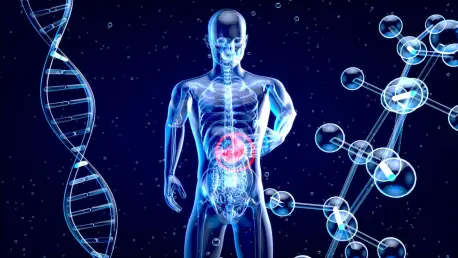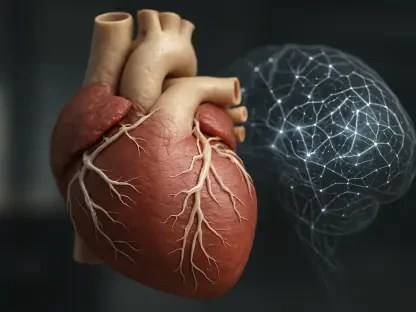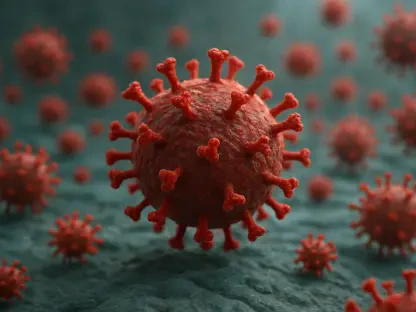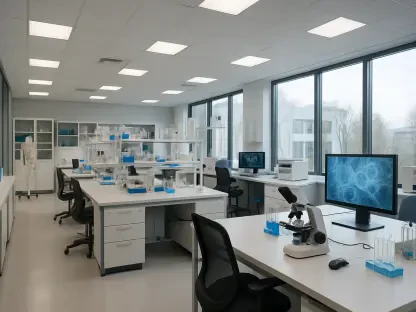In the rapidly evolving field of nuclear medicine, the phenomenon of non-specific uptake (NSU) of 68Ga-FAPI during positron emission tomography/computed tomography (PET/CT) imaging has emerged as a significant diagnostic challenge, particularly when observed in the pancreas of patients with no apparent signs of disease. This tracer, designed to target fibroblast activation protein (FAP), is celebrated for its sensitivity in detecting cancer-associated fibroblasts, yet it often reveals unexpected uptake in tissues like the pancreas, even in the absence of tumors or inflammation such as pancreatitis. Such occurrences can lead to critical misdiagnoses, where benign uptake is mistaken for malignant lesions, potentially resulting in unnecessary interventions or heightened patient anxiety. As 68Ga-FAPI PET/CT becomes increasingly integral to cancer staging and treatment evaluation, understanding the underlying reasons for this NSU is paramount to improving diagnostic accuracy. The implications of misinterpreting these imaging results are far-reaching, affecting treatment plans and patient outcomes in profound ways. This article delves into the causes and contributing factors behind pancreatic NSU, exploring recent research findings and offering insights into how clinicians can better navigate these complex imaging scenarios. By shedding light on this perplexing issue, the discussion aims to bridge the gap between innovative imaging technology and practical clinical application, ensuring that patients receive the most accurate diagnoses possible.
Unveiling the Role of 68Ga-FAPI PET/CT in Modern Imaging
The advent of 68Ga-FAPI PET/CT has marked a significant milestone in medical imaging, particularly within the realm of oncology, where it excels at targeting fibroblast activation protein (FAP), a protein often overexpressed in cancer-associated fibroblasts surrounding tumors. This imaging modality has proven especially valuable for detecting epithelial-origin tumors with high sensitivity, aiding in precise disease staging and evaluating therapeutic responses over time. Its ability to highlight areas of active fibroblast activity offers a unique window into the tumor microenvironment, providing clinicians with critical data to tailor treatment strategies. However, the utility of this tracer extends beyond cancer, as FAP expression is not exclusive to malignant conditions. It can also manifest in non-cancerous states such as chronic inflammation, fibrosis, and tissue healing after intervention, leading to uptake in areas that are not necessarily pathological. In the context of the pancreas, normal tissue typically exhibits minimal FAPI uptake, making any significant signal a point of concern or curiosity for interpreting physicians. When NSU occurs in this organ without corresponding clinical evidence of disease, it raises pressing questions about the underlying mechanisms driving such patterns. Addressing these anomalies is essential to prevent diagnostic errors that could derail patient care, ensuring that the benefits of this advanced imaging tool are not undermined by misinterpretation.
Moreover, the increasing reliance on 68Ga-FAPI PET/CT in clinical settings amplifies the urgency to understand its behavior in non-malignant contexts, especially in organs like the pancreas where baseline uptake is expected to be low. The tracer’s sensitivity, while a strength, also becomes a potential pitfall when uptake appears in unexpected regions, prompting the need for a deeper exploration of physiological and systemic factors that might influence its distribution. Conditions such as inflammation or metabolic disturbances could activate fibroblasts in subtle ways, contributing to imaging signals that mimic malignancy. This complexity underscores the importance of correlating imaging results with comprehensive patient histories and additional diagnostic tests to build a complete clinical picture. By refining the interpretation of 68Ga-FAPI PET/CT scans, nuclear medicine specialists can mitigate the risk of false positives, ensuring that patients are neither over-treated nor under-diagnosed due to ambiguous findings. The journey to fully harness this technology involves not only leveraging its diagnostic power but also navigating its limitations with precision and care, particularly in challenging cases involving the pancreas.
Decoding the Mystery of Pancreatic Non-Specific Uptake
Non-specific uptake (NSU) of 68Ga-FAPI in the pancreas is defined as an increased signal on PET/CT imaging without any corresponding clinical or morphological evidence of disease, such as pancreatic tumors or pancreatitis, creating a diagnostic conundrum for clinicians. This diffuse uptake often presents a pattern that can closely resemble the signatures of cancerous lesions, leading to potential confusion during scan interpretation and raising the risk of incorrect conclusions about a patient’s condition. Unlike focal uptake, which has been documented in specific pancreatic abnormalities, diffuse NSU remains a less understood phenomenon, often overlooked in routine assessments despite its implications. The absence of visible abnormalities on complementary imaging modalities like CT or MRI further complicates the situation, as there are no structural clues to explain the heightened tracer activity. Recent research has turned its focus toward unraveling why this occurs in otherwise healthy pancreatic tissue, recognizing that solving this puzzle could significantly enhance diagnostic precision. By distinguishing between benign and malignant uptake, clinicians can avoid unnecessary procedures or delays in addressing true pathologies, ultimately improving patient outcomes through more informed decision-making.
The challenge of pancreatic NSU is compounded by the growing adoption of 68Ga-FAPI PET/CT as a standard tool for cancer management, necessitating a clearer understanding of its behavior across diverse patient populations. The potential for misdiagnosis not only affects individual treatment plans but also places an emotional burden on patients who may fear a cancer diagnosis based on ambiguous imaging results. Historical data and case reports have hinted at various non-malignant causes of uptake in other tissues, suggesting that systemic or subclinical processes might play a role in the pancreas as well. Identifying the root causes of this uptake requires a multidisciplinary approach, integrating imaging data with clinical insights to form a holistic view of each case. Efforts to address this issue are pivotal, as they pave the way for developing guidelines or protocols that help nuclear medicine professionals differentiate between harmless anomalies and serious conditions. Such advancements promise to refine the application of this powerful imaging technology, ensuring it serves as a reliable ally in the fight against cancer without introducing undue diagnostic uncertainty.
Research Insights into Pancreatic NSU Characteristics
A comprehensive study conducted at West China Hospital of Sichuan University provides critical insights into the phenomenon of non-specific uptake (NSU) of 68Ga-FAPI in the pancreas, involving a cohort of 122 patients who underwent PET/CT imaging for the staging or restaging of abdominal malignancies. This retrospective analysis meticulously categorized participants into two distinct groups: those exhibiting pancreatic NSU and those without, while carefully excluding individuals with any known pancreatic pathologies to ensure the focus remained on non-specific patterns. The research team employed a robust methodology, collecting detailed imaging data alongside clinical histories and laboratory results to identify potential correlations with NSU. Uptake intensity, measured as the maximum standardized uptake value (SUVmax), was assessed and compared with other imaging tracers like 18F-FDG to understand the relative behavior of 68Ga-FAPI in the pancreas. This systematic approach not only highlighted the prevalence of NSU in a significant subset of patients but also laid a strong foundation for exploring the characteristics and contributing factors behind these unexpected imaging findings, offering a clearer perspective on how to approach such cases in clinical practice.
Further examination of the study’s methodology reveals the depth of analysis applied to both imaging and patient data, ensuring a thorough understanding of NSU’s manifestations. The researchers paid close attention to variables such as patient demographics, medical histories including prior treatments, and a wide array of laboratory parameters to uncover any links to the observed uptake. By comparing SUVmax values between the NSU and non-NSU groups, significant differences emerged, indicating a marked increase in tracer activity among affected patients, even in the absence of structural abnormalities on CT scans. This finding reinforces the notion that NSU is a distinct phenomenon requiring specific attention beyond traditional imaging interpretations. Additionally, the comparison with 18F-FDG PET/CT in a subset of patients underscored the heightened sensitivity of 68Ga-FAPI, which, while beneficial for detecting subtle changes, also amplifies the risk of non-specific signals. These insights are invaluable for advancing the field of nuclear medicine, providing a stepping stone for future investigations into how best to contextualize and interpret these complex imaging results in a clinical setting.
Identifying Key Contributors to Pancreatic Uptake
The findings from the West China Hospital study illuminate several pivotal factors associated with non-specific uptake (NSU) of 68Ga-FAPI in the pancreas, offering clinicians crucial guidance for interpreting these imaging results. Among the most striking discoveries is the strong correlation between diabetes and increased pancreatic uptake, positioning it as a significant independent risk factor. This association suggests that underlying processes such as beta-cell inflammation or pancreatic fibrosis, common in diabetic patients, may enhance fibroblast activation protein (FAP) expression, thereby leading to higher tracer activity on PET/CT scans. Such a link highlights the necessity of considering a patient’s metabolic health when evaluating imaging outcomes, as systemic conditions can manifest locally in unexpected ways. Beyond diabetes, the study also points to other clinical variables that might influence uptake, emphasizing the multifaceted nature of NSU. Recognizing this connection can help prevent the misinterpretation of benign uptake as a malignant condition, reducing the likelihood of unwarranted interventions and ensuring that diagnostic efforts remain focused on the true underlying issues.
In addition to diabetes, the research identifies elevated levels of C-reactive protein (CRP), a well-known marker of inflammation, as another key predictor of pancreatic NSU, indicating a potential role for subclinical inflammatory processes in driving uptake. Patients with higher CRP levels demonstrated a positive correlation with increased SUVmax, suggesting that even in the absence of overt pancreatitis, subtle inflammation could activate fibroblasts and mimic cancerous patterns on imaging. Furthermore, lower hematocrit levels emerged as an independent factor associated with NSU, though the precise mechanism remains elusive and warrants further exploration. This hematologic connection might reflect broader systemic influences or predispositions to pancreatic changes that are not yet fully understood. These findings collectively underscore the importance of integrating laboratory data with imaging results to build a comprehensive diagnostic framework. By acknowledging these contributing factors, nuclear medicine specialists can approach 68Ga-FAPI PET/CT scans with greater caution and context, minimizing diagnostic errors and tailoring patient care to reflect the nuanced interplay of systemic and local conditions.
Implications and Future Directions for Clinical Practice
The identification of factors such as diabetes, elevated C-reactive protein (CRP), and lower hematocrit levels as contributors to non-specific uptake (NSU) of 68Ga-FAPI in the pancreas carries significant implications for clinical practice, particularly in the interpretation of PET/CT imaging. These insights provide nuclear medicine physicians with critical contextual clues that can guide the differentiation between benign uptake and potential malignancy, thereby reducing the risk of misdiagnosis that could lead to unnecessary procedures or delayed treatment for other conditions. For instance, knowing that a patient with diabetes is more prone to NSU allows clinicians to approach pancreatic signals with heightened scrutiny, possibly integrating additional diagnostic tools or follow-up imaging to confirm findings. Similarly, elevated CRP levels might prompt a search for underlying inflammatory states that could explain uptake without jumping to oncologic conclusions. This nuanced approach not only enhances diagnostic accuracy but also alleviates patient anxiety by avoiding premature assumptions about cancer, ensuring that care pathways are both precise and compassionate in addressing individual health profiles.
Looking ahead, the findings from this research pave the way for actionable next steps and future considerations in the field of nuclear medicine, particularly regarding the use of 68Ga-FAPI PET/CT. Developing standardized protocols or guidelines that incorporate these risk factors into imaging interpretation could streamline clinical decision-making, offering a structured framework for handling ambiguous cases. Moreover, there is a clear need for prospective studies with larger and more diverse patient cohorts to validate these associations and explore the long-term outcomes of patients exhibiting NSU. Investigating the biological mechanisms behind links such as lower hematocrit and pancreatic uptake could uncover new insights into systemic influences on local tissue responses. Additionally, comparative analyses between different FAPI tracers and other imaging modalities might reveal tracer-specific behaviors, further refining diagnostic approaches. By building on these research foundations, the medical community can work toward minimizing false positives, enhancing the reliability of this powerful imaging tool, and ultimately improving patient care through more informed and accurate diagnostic strategies.









